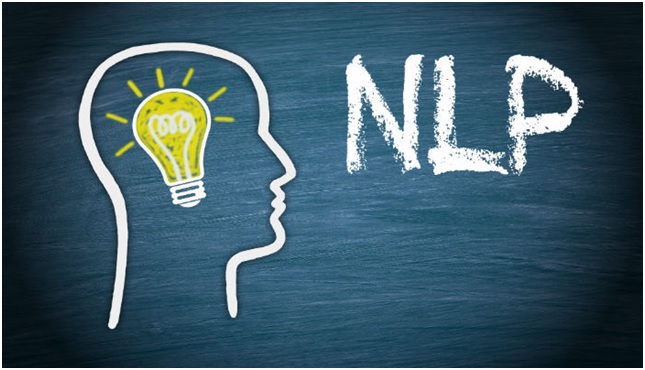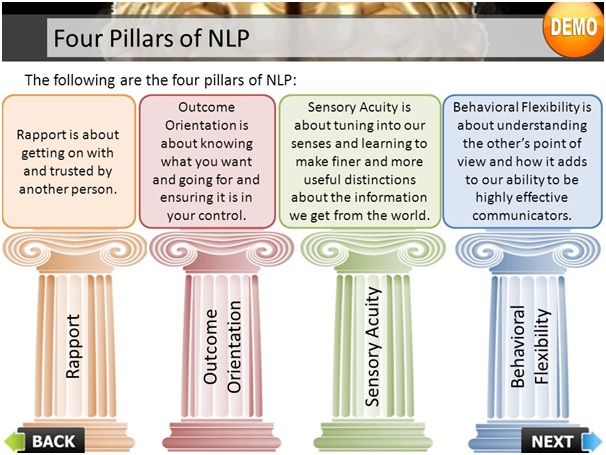
Research Paper By Robyn Goddard
(Executive Coach, UNITED STATES)

Introduction
Since its inception in the late 1960s, Neuro-Linguistic Programming has become more widely used everywhere from sports to therapy, coaching and education. This in part is due to its practical and diverse applicability.
The purpose of this research paper is to discuss the fundamentals of NeuroLinguistic Programming and its practical application in coaching. It will also detail why coaching is unanimously effective for professionals of all kinds and is infused with several case study examples for additional support.
Neuro-Linguistic Programming
Neuro-Linguistic Programming (NLP) is defined as the “systemic study of human communication and how humans create their reality”. NLP Involves a strategic approach to self-improvement and is utilized primarily to help enhance an individual’s performance and maintain a stronger regulation over their emotional states and focus.
The terminology was coined in the late 1960s by Richard Bandler who at the time, was enveloped in his undergraduate studies with the University of California. Bandler ironically enough was a computer science student yet maintained a strong interest in psychotherapy.
He and his colleagues were struck by how ineffective most forms of therapy were, however, were surprised to find two specific therapists who consistently achieved results by the name of Virginia Satir and Fritz Perls.
The term encompasses what can arguably be considered the “three most influential components involved in producing human experience”. These include neurology (neuro), language (linguistic) and programming (programming).
Neuro:
A word-forming element of Greek origin pertaining to the nervous system, specifically in this case, the brain the manner in which individuals uses their senses to understand and process their environment.
Linguistic:
The field of linguistics involves the scientific study of language as well as its “nature, structure, and modification”.
Programming:
Programming involves an individual’s behaviour, specifically the way in which individuals organize ideas and actions and the results, whether expected or unexpected, which these processes result in.
Besides your native language, how many languages are you intrinsically familiar with? Are you aware of the language in which your mind speaks?
Learning how the brain communicates the physical, emotional and psychological needs are the foundations which make neuro-linguistic-programming so effective in helping to facilitate change of destructive thought and behavioural patterns.
It is for this reason that NLP has gained such popular support in psychotherapy today. You can see its widespread impacts in specialties such as coaching, personal training, public speaking, hypnotherapy, as well as countless other professions.

Primary Principles
There are two primary presuppositions that the NLP school of thought is rooted in. The first presupposition is that as human beings, we can never know the true reality, but only our perceptions of such reality.
These ‘neuro-linguistic maps’ are the only manner in which we experience and respond to the world around us. As a result, we are generally not so much limited by our reality, but by our preconceived notions or limiting perceptions of our reality.
The second presupposition is that our minds and lives are in fact, systemic processes. According to NLP University, “our bodies, our societies, and our universe form an ecology of complex systems and sub-systems, all of which interact with and mutually influence each other”.
Neuro-Linguistic Programming is also based on four primary principals which can be described as follows:
- Rapport – Establishing rapport is fundamentally essential to any form of communication
Outcome – Every individual already has access to the various tools needed to drive success in their lives, but not every individual innately understands how to “unlock” these tools. Every individual is also directly responsible for and in charge of their life and its outcome.
- Feedback – Success of communication is measured by the response received and as one learns to communicate more efficiently and effectively, the world around them will respond in hand.
- Flexibility – People are not their behaviour, and their behaviour is flexible and subject to change.
The roots of NLP stem from schools of rational thought and NLP is found to be effective only when any or all of the primary principles/core pillars are met.
The first pillar of Neuro-Linguistic Programming starts with YOU, then proceeds the second which focuses on one’s communication skills. The third deals with your perception of both yourself as well as your present and future and the final pillar focus on awareness of senses and adaptability.
Application
NLP has become increasingly popular within the coaching, self-help, education and therapy sectors, however, is technically defined separately from therapy. NLP is considered an educational process of sorts that can be applied to situations which traditional psychotherapy is not naturally geared towards resolving.
Whether you’re a professional individual or running a business, the application of Neuro-Linguistic Programming can yield superb results.
In fact, did you know that NLP is one of the oldest tricks in the book for persuasive sales talks?
If you’re an entrepreneur, NLP can help you hone your communication skills. If you’re a smoker, NLP can help in nicotine cessation without fail. Moreover, NLP is the trending solution in psychotherapy through counselling today. Whoever you are, NLP can help you turn your life around.
Benefits
, Unlike hypnotherapy, NLP works through a conscious network of mutual connections around us. It has helped several hundreds of people get rid of anxiety, depression, anger and a lot more. According to scientists, NLP helps in five primary ways:
1. Change of Thoughts
Also referred to as objective analysis, you can use NLP to change your thoughts as well as the way your mind thinks.
2. Balancing your Emotions
NLP for emotional intelligence is crucial for finding positive channels to use emotional energies. It can also teach you to find emotional stability.
3. Firing your Creative Consciousness
Say goodbye to imagination blocks with NLP as it nurtures and guides you into realistic ways to stay creative throughout life.
Break Free from Faith that Shrinks your Skills and Recognizes the True Potential
4. Tone your Communication Skills
If you have problems expressing your ideas and thoughts in clarity, NLP can help you by teaching the basics of good listening and speaking skills.
Neuro-Linguistic-Programming Leads the Way to Winning Outcomes
5. Make Way for Accelerated Learning
Once you’ve trained your emotional mind with NLP, you’ve passed the first step of accelerated learning. After concreting your core beliefs, NLP will teach you to use productive tools and techniques for learning faster.
Case Studies on the Effectiveness of Neuro-linguistic Programming
How NLP Worked on Occupational Stress in Critical Care Nurses
According to the case study published in the Iranian Journal by three scientists, NLP can reduce the stress of nurses by half. The staggering conclusion was recognized after surveying 60 nurses with parameters such as Expanding Nurse Stress Scale (ENSS), Man-Whitney Test and Chi-Tests.
Out of the 60 nurses in critical care who signed yes for the survey, the researchers divided people into experimental and control groups with the former being NLP treated people and the latter the control group. After conducting up to 18 sets of 180-minute sessions with the experimental groups, statistics of the experiment were recorded.
What the Researchers Found
Job stress when recorded for nurses in the critical unit before the experiment was 120 to 121 while it halved to 64.53 for the experimental group of nurses. However, the control group remained at 120.96!
Impact of NLP in Schools From Teachers
When CfBT conducted research on the efficacy of neuro-linguistic programming in schools, they found evidence of thriving NLP practices, apart from positive results. NLP helps teachers communicate with their class children proficiently. We have deduced five significant results from five case studies in the 24 published by teachers from around the country.
Questioning
The behavioural attitude of students can be changed when you use meta-model questioning. It builds a framework for discussion. When one of the teachers in the case study asked about home and life decisions, emotional imbalance in various children came to light.
Another observation entailed a child who was shown to be seemingly disinterested in class discussions and perpetually tired. When asked Meta Model Question as to why he yawned led to a class debate on when to sleep. The child agreed to sleep early. Besides, the child was engrossed in the discussion and yawned but once in the whole week.
Questions like what do you think, what do you want to do, why do you want to do it and so on by teachers helped students make goals they passed.
Anchoring
When teachers applied NLP using anchoring to catch the students’ attention, it was a big success. One teacher used hand movements to stop chatting behaviour of the class while another teacher used time-out-five to stop negative behaviours.
Eye Accessing Cues
When NLP was tried with students, teachers found positive results. For students who were asked to spell words, most had a look and say approach, where they would imagine the word above them or with closed eyes before spelling or writing it. When the student looked down, it was a signal he or she did not know the answer.
Teachers observed significant improvements in students showed when encouraged to write the word to a student who looked down. Simply put, eye accessing cues build confidence in children.
Milton Model
When a nursery school teacher tried Milton Model against the Meta Model, the former showed excellent changes in the attitude of the child. As the kid was unruly and disobedient, the teacher softened her voice and asked the child for help on ‘how she would make the nursery a happy place’. To the shocked teacher, the kid earnestly showed ways to behave and help around.
Submodalities and Visualization
Your senses are considered “modalities” in NLP terms and each modality is comprised of what is coined “submodalities”. These submodalities are parts of each system which encode and give meaning to the experiences we have. Various teachers showed starting the class with visual imageries using sentences starting with ‘Just Image’ or ‘Think about’ makes the students more focused on the class.
When another teacher asked a child to visualize with the teacher about a storytelling work, he produced great results. After a few weeks of drip-feeding or instructing to visualize, the child grew the skill of writing stories in his leisure too.
Conclusion
NLP refers to communicating with the brain in the language in which it is most naturally fluent. From teaching organization to management, strategizing and communication skills, Neuro-Linguistic-Programming works effectively in practically any field of work imaginable.
As we saw from the various case studies, NLP can change attitude, stress and perception of reality to the point that it can fundamentally alter life for the better. This is precisely why it is an exceptional basis for a coaching model.